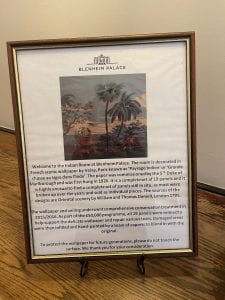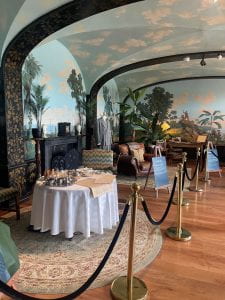Walking through Blenheim Palace, you are met with breathtaking architecture and lavish decor that depicts the indulgent and excessive lives that the British elites of history lived in. One of Blenheims’ unique aspects when compared to other luxurious British palaces is their connection to Winston Churchill. To them, this is an honor, and as such, they have dedicated a whole section of the palace to be an exhibit on the life and legacy of Churchill. When walking through this exhibit, you pass Churchill’s childhood clothes, furniture, and schoolwork, before seeing the exhibits on his legacy as a brilliant soldier and heroic Prime Minister. Between these two areas, one may notice a doorway to the side with a small frame labeling it with even smaller text, The Indian Roon.
If you asked someone from India what they believed an exhibit on the Legacy of Churchill should include, especially regarding his legacy in India, it would not look anything like what you see at Blenheim Palace. The Indian Room is their superficial acknowledgment that Churchill’s legacy has to include some mention of India, but in order to retain his image as the “greatest Briton” of all time, there is no acknowledgment of what that legacy actually includes.
Churchhill might have been great towards the people of his own country, but he was markedly less so towards the people living in Britains’ imperial empire. A die-hard imperialist, Churchill vehemently opposed India gaining independence and was well known for his outspoken hatred towards Mahatma Gandhi (Trautman 206).
The Bengal Famine was a major point of contention concerning Churchill’s attitude towards India, besides Independence. The Bengal Famine was triggered in 1942 by a cyclone and flooding, but Churchill’s handling of the situation, many argue, made things much worse. It has been found that Churchhill’s government ignored India’s pleas for help for many months as he feared that sending India food would reduce the UK’s stockpiles and distract ships and crews from the war. Another policy that has been widely criticized was his denial policy, where crops and ships that transported them would be destroyed in order to prevent Japanese invaders from having enough resources to expand their own rule.
This all happened at the same time that India sent millions of their people to become soldiers and fight in World War 2. In this vein, Churchill sent Indians to die either in battle or by starvation.
This part of Churchill’s legacy is not mentioned in The Indian Room. This Indian Room is simply a continuance of Britains’ and, specifically, Churchills’ legacy of imperialism. While Blenheim Palace can claim that they acknowledge Churchill’s lagacy in India, they have done the absolute bare minimum. This part of history is being glossed over by making the room easy to pass by and not giving visitors any context regarding Churchill’s impact on India.
Blenheim Palace is a beautiful site full of rich history, but it falls short of giving context to Britains’ more shameful side of history. The Indian Room needs to be given the proper context. As a historical site, Blenheim needs to acknowledge the darker aspects of Churchill’s legacy, lest they continue to perpetuate the colonial legacy of Great Britain.



